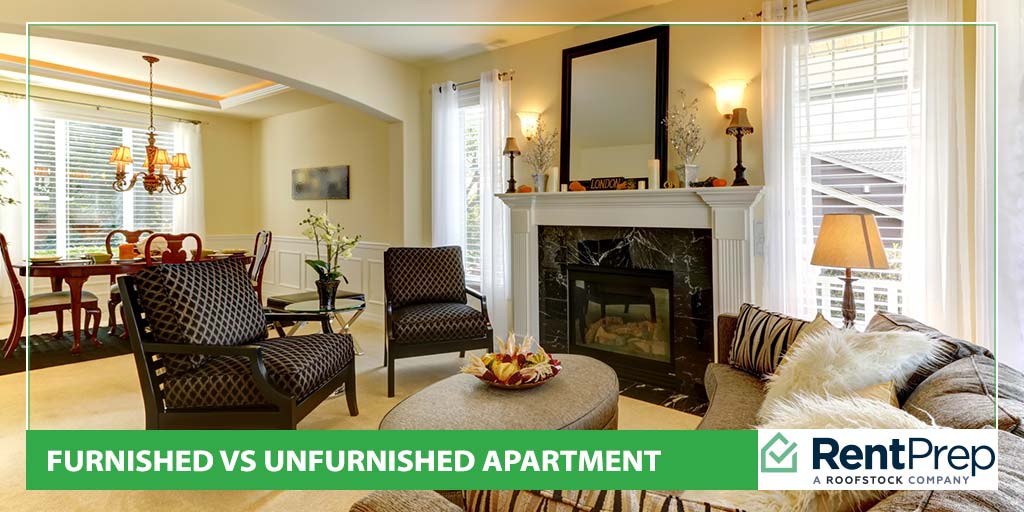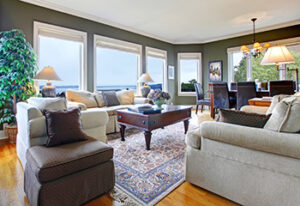
As landlords try to entice quality renters to sign lease agreements, many debate the merits of a furnished vs unfurnished apartment. There are many benefits to offering a furnished or semi-furnished rental property, such as higher rent, but there are some downsides as well.
The best thing a landlord can do is evaluate the pros and cons of furnishing the rental property and see how it matches up to the needs of renters in the area.
What is a Furnished Apartment?
A furnished apartment comes with all the furniture that a reasonable person would need to live comfortably. A furnished apartment typically will command higher rents compared to comparable rentals that are unfurnished since depreciation will occur to assets such as couches, tables, and chairs.
- A living room should have at least a sofa, table and lamp and perhaps a coffee table or bookshelf.
- A bedroom should have a bed, nightstand with lamp, a dresser, and perhaps a desk.
- A dining area should have a table and chairs.
- A bathroom should have a shower curtain, wastebasket, and floor mat.
- A kitchen should be fully stocked with utensils, dishes, glassware, and pots and pans, along with all appliances.
What does fully furnished mean?

A fully furnished apartment means that someone can move into the apartment and live without purchasing any items for the apartment. This does not include things such as food, perishable items, or personal items.
However, a renter should be able to walk in with a suitcase and feel ready to live in the apartment. Items like toiletries, dish soap, and hand soaps may be supplied upfront but are typically the responsibility of the renter going forward.
What is a semi-furnished apartment?
The term “semi-furnished” can be used to describe a range of rental properties, from nearly bare to almost fully furnished. In general, a semi-furnished apartment usually has the basic big pieces of furniture—sofa, bed, dresser, and table and chairs—with fewer small pieces present.
You may not expect kitchen utensils in a semi-furnished rental where those would be present in a fully furnished apartment.
3 Pros of Furnished Apartment Rentals
Below are the pros of furnishing your rental property:
Furnished vs Unfurnished Price Difference
In most cities across the country, furnished apartments cost more to rent than unfurnished, so landlords can charge a higher rent. Many renters feel that it’s worth it because it saves them from having to purchase furniture.
The price difference will vary widely from city to city and in many cases furnished lease agreements are shorter than unfurnished ones. This is due to the fact that many people seeking a furnished apartment are looking for temporary housing. Typical rents for short-term housing are higher because the owner needs to offset any costs of increased vacancies created by shorter lease lengths. It’s not uncommon for a furnished apartment to rent for 20-40% higher than an unfurnished apartment. For short-term stays, under a month that number will increase further.
Higher security deposit
Landlords can also charge more of a deposit for fully furnished apartments. For example, in some states, landlords can only charge a certain maximum deposit for unfurnished, but a higher maximum amount for furnished ones. This is to protect the landlord in covering the cost of replacing or repairing damaged furniture.
Predictable target market

Because furnished apartment cost more, landlords automatically attract tenants who can afford that—often young professionals, young families or students who haven’t accumulated their own furnishings. If the rental property is in a college town or in a more urban area, chances are there are plenty of potential tenants looking for such a rental and a landlord could benefit from catering to this market.
3 Cons of Furnished Apartment Rentals
While there are many pros, there are a few cons to offering a furnished rental:
Higher potential for damages
Furnishing an apartment means that there is more potential for damage, which means a greater financial burden if tenants do not take care of the property and the furnishings inside it. Repair and replacement responsibilities increase with a furnished apartment as landlords must watch out for actual damages and stay ahead of normal wear and tear. Because furniture eventually wears out, landlords should plan on replacement pieces over time so the rental stays attractive instead of shabby.
Higher turnover
Another drawback to renting out a furnished property is that tenants often trend toward shorter-term lease agreements. Young professionals, students, singles, young families and others who don’t have many material goods usually seek out furnished dwellings because they are more likely to be transitory, due to job transfers, school graduation or life changes.
Storage costs
Landlords must arrange for storage if the furniture can’t stay in the rental property. For example, if the landlord agrees and tenants wants to use their own mattresses and bedframe, the landlord is responsible for moving the existing bed and finding storage for it. Similarly, if the landlord wants to paint or re-carpet between vacancies, he must make arrangements for moving and/or storing the furniture so the work crews can get the job done.
Ultimately, choosing to rent out a furnished or unfurnished property really depends on the target market. Since students and young professionals tend to rent furnished properties, while couples and families prefer unfurnished units, each landlord must decide which condition results in plenty of qualified tenants.

